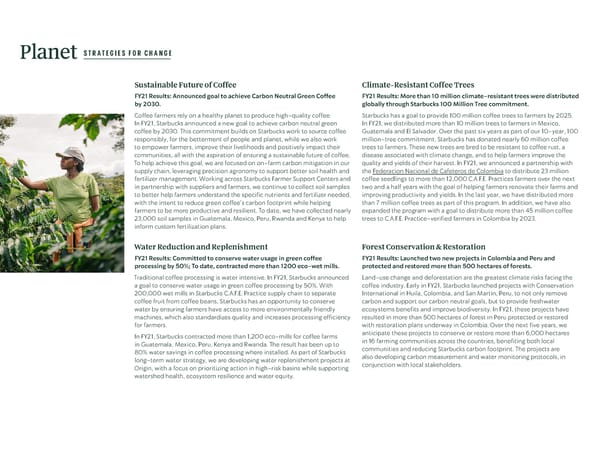STRATEGIES FOR CHANGE Planet Sustainable Future of Coffee Climate-Resistant Coffee Trees FY21 Results: Announced goal to achieve Carbon Neutral Green Coffee FY21 Results: More than 10 million climate-resistant trees were distributed by 2030. globally through Starbucks 100 Million Tree commitment. Coffee farmers rely on a healthy planet to produce high-quality coffee. Starbucks has a goal to provide 100 million coffee trees to farmers by 2025. In FY21, Starbucks announced a new goal to achieve carbon neutral green In FY21, we distributed more than 10 million trees to farmers in Mexico, coffee by 2030. This commitment builds on Starbucks work to source coffee Guatemala and El Salvador. Over the past six years as part of our 10-year, 100 responsibly, for the betterment of people and planet, while we also work million-tree commitment, Starbucks has donated nearly 60 million coffee to empower farmers, improve their livelihoods and positively impact their trees to farmers. These new trees are bred to be resistant to coffee rust, a communities, all with the aspiration of ensuring a sustainable future of coffee. disease associated with climate change, and to help farmers improve the To help achieve this goal, we are focused on on-farm carbon mitigation in our quality and yields of their harvest. In FY21, we announced a partnership with supply chain, leveraging precision agronomy to support better soil health and the Federacion Nacional de Cafeteros de Colombia to distribute 23 million fertilizer management. Working across Starbucks Farmer Support Centers and coffee seedlings to more than 12,000 C.A.F.E. Practices farmers over the next in partnership with suppliers and farmers, we continue to collect soil samples two and a half years with the goal of helping farmers renovate their farms and to better help farmers understand the specific nutrients and fertilizer needed, improving productivity and yields. In the last year, we have distributed more with the intent to reduce green coffee’s carbon footprint while helping than 7 million coffee trees as part of this program. In addition, we have also farmers to be more productive and resilient. To date, we have collected nearly expanded the program with a goal to distribute more than 45 million coffee 23,000 soil samples in Guatemala, Mexico, Peru, Rwanda and Kenya to help trees to C.A.F.E. Practice-verified farmers in Colombia by 2023. inform custom fertilization plans. Water Reduction and Replenishment Forest Conservation & Restoration FY21 Results: Committed to conserve water usage in green coffee FY21 Results: Launched two new projects in Colombia and Peru and processing by 50%; To date, contracted more than 1200 eco-wet mills. protected and restored more than 500 hectares of forests. Traditional coffee processing is water intensive. In FY21, Starbucks announced Land-use change and deforestation are the greatest climate risks facing the a goal to conserve water usage in green coffee processing by 50%. With coffee industry. Early in FY21, Starbucks launched projects with Conservation 200,000 wet mills in Starbucks C.A.F.E. Practice supply chain to separate International in Huila, Colombia, and San Martin, Peru, to not only remove coffee fruit from coffee beans, Starbucks has an opportunity to conserve carbon and support our carbon neutral goals, but to provide freshwater water by ensuring farmers have access to more environmentally friendly ecosystems benefits and improve biodiversity. In FY21, these projects have machines, which also standardizes quality and increases processing efficiency resulted in more than 500 hectares of forest in Peru protected or restored for farmers. with restoration plans underway in Colombia. Over the next five years, we In FY21, Starbucks contracted more than 1,200 eco-mills for coffee farms anticipate these projects to conserve or restore more than 6,000 hectares in Guatemala, Mexico, Peru, Kenya and Rwanda. The result has been up to in 16 farming communities across the countries, benefiting both local 80% water savings in coffee processing where installed. As part of Starbucks communities and reducing Starbucks carbon footprint. The projects are long-term water strategy, we are developing water replenishment projects at also developing carbon measurement and water monitoring protocols, in Origin, with a focus on prioritizing action in high-risk basins while supporting conjunction with local stakeholders. watershed health, ecosystem resilience and water equity.
 ESG Report | Starbucks Page 37 Page 39
ESG Report | Starbucks Page 37 Page 39